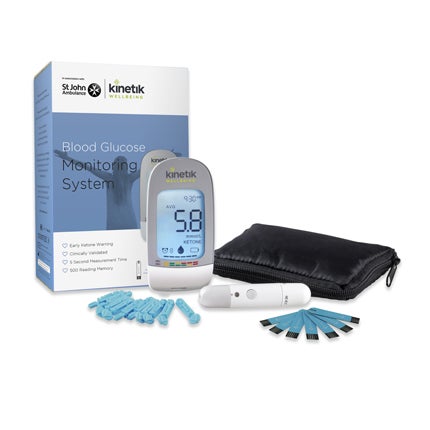Here’s what you need to know about your blood sugar levels


NEW on the WeightWatchers® Shop: Blood Glucose Monitor

Dr Ravi says...

“Around 4.7 million people have diabetes in the UK with someone being diagnosed every two minutes. Worryingly, one million of those people have Type 2 diabetes that has not yet been diagnosed. This is alarming as there are many serious complications associated with Type 2 diabetes, these can affect your eyesight, kidneys, nervous system and many more. This indicates the importance for regular blood glucose monitoring.1
“Early detection of elevating blood glucose levels is important because if acted on immediately, it can help prevent the onset of developing full-blown diabetes. This is particularly relevant for pre-diabetes which is when your blood sugar levels are above the normal range, but not high enough to be diagnosed as having diabetes. The worrying thing is that pre-diabetes doesn’t have any symptoms - if you start to have any of the symptoms of Type 2 diabetes it means you have probably already developed it. This highlights the need to regularly check your blood glucose levels to ensure you detect any elevations early when you still have control and can potentially reverse any complications.”2
What is blood sugar?
Blood sugar, also known as blood glucose, comes directly from the food you eat. When you eat food containing carbohydrates (like bread, pasta and potatoes), they are digested into glucose molecules, which then circulate in your bloodstream.
Blood glucose is used for energy, and any which isn’t needed right away gets stored in your cells for later use.3
What happens to my blood sugar levels when I eat?
Your body is constantly working to keep the level of sugar in your blood within a certain range, as too high or too low can be harmful.
To keep your blood glucose in the healthy range, your pancreas releases two hormones: insulin, which lowers blood sugar (for example, after a meal) and glucagon, which raises blood sugar when needed (for example, during a workout). Insulin and glucagon work together to keep blood glucose levels balanced.
Insulin acts to move glucose from your bloodstream into your liver and muscle cells, where it’s stored as glycogen. This prevents blood sugar levels from getting too high.
It also creates energy stores, which your body can tap into between meals, during a workout, or as otherwise needed. When more sugar is required in your blood, glucagon is released, your cells turn glycogen back into glucose, and glucose is released back into your bloodstream.4
Blood sugar levels: what’s normal?
Blood sugar is measured in millimoles per litre (mmol/L).
For the majority of healthy individuals, normal blood sugar levels are between 4.0 to 5.4 mmol/L (72 to 99 mg/dL) when fasting, and up to 7.8 mmol/L (140 mg/dL) 2 hours after eating.5
Click here to view target blood glucose levels for adults with Type 1 and Type 2 diabetes, and children with Type 1 diabetes.
Use a reliable blood glucose monitor to find your blood sugar levels.
The more carbohydrates you eat, the more glucose that will be released into your circulation. The foods that generate the biggest spike in your blood sugar are those high in processed carbohydrates. These include white bread, white grain products (like pasta and rice), processed cereals, cookies & cakes, and sugary drinks.6
If your blood sugar levels are too high, you may be at risk of developing Type 2 diabetes.
What is diabetes?
When the body is unable to produce insulin, or the insulin you’re producing isn’t causing the response it should, blood glucose levels get too high and you can end up with excess sugar in your blood. Over time, this can cause damage and put you at risk of developing diabetes.
What’s the difference between Type 1 and Type 2 diabetes?
There are two main types of diabetes: Type 1 and Type 2.
Type 1 diabetes is an autoimmune condition, and makes up about 10% of total cases of diabetes in the UK. With Type 1 diabetes, the body is not able to make insulin because the cells of the pancreas that normally produce insulin have been destroyed by the body’s own immune system. We don’t entirely know why this happens in some people and not others.
Type 2 diabetes is more common and makes up about 90% of total cases of diabetes in the UK. It usually develops later in life, although it can affect people of any age. With Type 2 diabetes, the pancreas still has the ability to produce insulin, but it may not be producing enough, or the body may have stopped responding properly to the insulin that is being produced.
Type 1 diabetes cannot be prevented. However, you can reduce your risk of developing Type 2 diabetes, usually through a combination of healthy diet and physical activity.
Symptoms & complications of Type 2 diabetes
Many people have Type 2 diabetes without realising. This is because symptoms do not necessarily make you feel unwell.
Symptoms of Type 2 diabetes include:
- Urinating more than usual, particularly at night
- Feeling thirsty all the time
- Feeling very tired
- Losing weight without trying to
- Cuts or wounds taking longer to heal
- Blurred vision7
Type 2 diabetes complications include:
- Heart disease and stroke
- Loss of feeling and pain (nerve damage)
- Foot problems – like sores and infections
- Vision loss and blindness
- Miscarriage and stillbirth
- Problems with your kidneys8
WW x NDPP
WW is one of the chosen providers for the NHSE Diabetes Prevention Programme. This means that patients in the pre-diabetic range can now be referred to the WW weight-loss programme by their GP in specific locations, where they will receive personalised support to reduce their risk of Type 2 diabetes, including guidance on healthy eating, weight loss (if required), physical activity and overall wellbeing. This holistic approach has been proven to reduce the risk of developing diabetes. Find out more about our partnership with the NHS.
Dr Ravi’s top tip
Your risk of Type 2 diabetes can be reduced by applying simple lifestyle changes like:
- Eating healthy food
- Doing more physical activity
- Losing weight, if you're overweight
If you are overweight and at high risk of Type 2 diabetes, losing just 5% of your body weight can significantly reduce your risk. Making healthier food choices and being more active are both positive ways to start making these changes.
1. https://www.diabetes.org.uk/professionals/position-statements-reports/statistics
2. https://www.diabetes.org.uk/preventing-type-2-diabetes/prediabetes
3. https://www.healthline.com/health/and-after-effect-eating-blood-sugar
4. https://www.livescience.com/62673-what-is-blood-sugar.html
5. https://www.diabetes.co.uk/diabetes_care/blood-sugar-level-ranges.html
6. https://www.weightwatchers.com/uk/introducing-diabetes-and-debunking-diabetes-myths
7. https://www.nhs.uk/conditions/type-2-diabetes/symptoms/
8. https://www.nhs.uk/conditions/type-2-diabetes/health-problems/